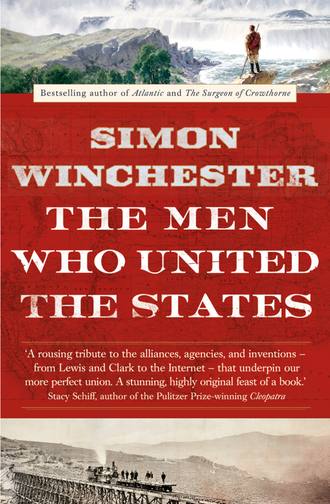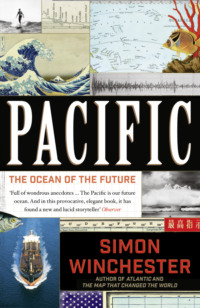
Полная версия
The Men Who United the States: The Amazing Stories of the Explorers, Inventors and Mavericks Who Made America
The plains grasses from which these bison fashion their cud are of very different kinds and appearance, depending largely on the rainfall, the mean temperatures, and the thickness of the soil. Latitude plays its own part, of course; but longitude has the greater role in dividing each from each. Generally speaking, the Great Plains extend between the 95th and 105th meridians—with the midline, the line marking 100 degrees west of Greenwich, denoting by tidy coincidence the approximate limit of twenty inches of rainfall a year: west of the line is drier, true rain-shadow country, while to its east the rainfall becomes ever more abundant and more steady. Altitude plays a part also: because the plains generally slope downward from west to east, from the Rockies to the Missouri River, the western plains are higher, the made-for-movies hardscrabble country of the High Plains, indeed.
This is the great Dust-Bowl-to-be country, rarely much good for agriculture, where otherwise munificent bankers were traditionally reluctant to lend to settlers who were proposing to live there and farm. In this western dry country, the plains are dominated by very short tufted grasses like fescue and needlegrass, and later by hardy imports like crested wheatgrass.
On the 100th meridian itself, in the midplains, there is more of a mix. In what is now Nebraska, say, with its wide, empty farm fields, Willa Cather’s famous “shaggy coat of the prairie” has a pile six feet high at least, made of deep big bluestem, Panicum witchgrass, wild rye, perennial tussock grasses like yellow Indiangrass, and a weave of flowering timothy and blue grama. (The last is a prairie grass that currently displays its own limitations, for it manages at once to be sufficiently abundant to be the official state grass of Colorado and yet is classified as endangered only five hundred miles east in Illinois, whose western counties, if not quite the Great Plains, are very much a part of the tallgrass prairie.)
Lewis and Clark saw all of these grasses—even timothy, the only non-native of the group, which had been introduced from Europe more than a century before and had spread across the nation with astonishing speed. But one plant they would not have seen, despite its now being a near-legendary symbol of the plains—was tumbleweed.
The image of tumbleweed—a ghostly botanical thing looking like a bouffant hairpiece, bouncing steadily across a dusty road before a cold and gritty wind, lodging itself eventually in a barbed-wire fence—is persistent, emblematic, frequently adopted by Hollywood, and generally best viewed on the screen in black-and-white. In most cases, the plant involved is the Russian thistle, Salsola tragus, a pest of a weed, loathed by farmers. The reason Lewis and Clark never reported seeing it is that they arrived too early on the scene by many decades: the vanguard of the tumbleweed invasion came with the accidental importation of thistle seeds in a sack of flax brought to the Dakotas by settlers in the 1870s, six decades after the Corps of Discovery had passed by. It is now just about everywhere, occurring clear across the middle country, from the dusty American West to the lush soils of the Missouri Valley.
It was the eastern tallgrass prairie that Lewis and Clark would have first glimpsed when they made initial contact with the plains during their gentle upriver paddle through what is now Kansas, Nebraska, and the Dakotas. On July 4, for instance, when the party was near Leavenworth, Kansas, Clark wrote:
The Plains of this countrey are covered with a Leek Green Grass, well calculated for the sweetest and most nourishing hay—interspersed with cops of trees. Spreding their lofty branches over Pools Springs or Brooks of fine water. Groops of shrubs covered with the most delicious froot is to be seen in every direction, and nature appears to have exerted herself to butify the Senery by the variety of flours … raised above the Grass, which Strikes and profumes the Sensation, and amuses the mind.
Clark’s “Leek Green Grass” of 1804 is simply today’s big bluestem, the classic of the tall grasses. Its appearance among the scattered copses here hints at the borderline between prairie proper and Great Plains. And Clark is prescient indeed in remarking on its “sweetness” and on the “froot.” This tract of countryside, with its two-foot-deep soil that once gave support to these long grasses, would (once John Deere had perfected his steel plow blade in the 1830s to create a splendid tilth) become America’s present-day granary, with section after section laid to the endless acres of wheat and corn of the richest and most productive grain belt in the world.
But that is the eastern edge, where the soils are rich and fertile. Just six scant weeks and seven hundred miles later, when the expedition had come to what is now Fort Thompson, South Dakota, all had changed. The men had by now passed the mouth of the sand-laden Platte River. Frontiersmen scorned this long and wandering stream, “a mile wide and six inches deep,” as “too thick to drink, too thin to plow,” and held that passing northward over it held a symbolism similar to crossing the equator. The explorers were now in a harsher, drier territory, a wilderness of small braided streams, alkaline flats, and immense buffalo herds, where small cottonwood groves grew only in the deeper stream valleys and where the rich planting soil had given way to rougher grazing land, as Lewis himself noted:
I found the country in every direction for about three miles intersected with deep revenes and steep irregular hills of 100 to 200 feet high; at the tops of these hills the country breaks of as usual into a fine leavel plain extending as far as the eye can reach … [T]he surrounding country had been birnt about a month before and young grass had now sprung up to a hight of 4 Inches presenting the live green of the spring … [T]his scenery already rich pleasing and beautiful, was still hightened by immence herds of Buffaloe deer Elk and Antelopes which we saw on every direction feeding on the hills and plains.
North of the Platte, they had now passed into the true short-grass prairie, and they would have made it farther west, perhaps into the High Plains themselves, had not winter intervened. The first snows came in October. The Missouri was by now substantially shallower, slower moving, and, free of the Platte sands, clearer and purer. As destined by its hydrodynamics it soon started to freeze, and the expedition was obliged to set down its planned winter camp.
By now the expedition had already begun to encounter scatterings of Indians—and in November would meet with one group of Native Americans—and one Native American in particular—who would profoundly change the tempo, the temper, and the reputation of their adventure.
ENCOUNTERS WITH THE SIOUX
The smallest commercial nuclear power station in America is in Nebraska, standing slightly sheepishly on the west bank of the Missouri. Since 1973 it has supplied with a fair degree of constancy (though lately interrupted by flooding) a modest amount of electric power to the city of Omaha, forty miles to its south. It is officially the Fort Calhoun Nuclear Generating Station, and it stands more or less on the very point, just around river milepost 645, where Lewis and Clark had their first official meeting with a delegation of Indian chiefs.
The encounter took place on August 3, 1804, three months out from Saint Charles. The chiefs were from one of the country’s lesser seminomadic peoples, the Otoe tribe. They were not the first Indians the explorers had seen. Every so often, Clark noted in his diary having passed by trapper boats, with usually a Frenchman and a native client aboard, but these Otoe were the first to be properly and formally met. And the explorers were fully prepared for them, backed as they were by the full authority of the White House, with dozens of preprinted forms on stiff white card ready to hand out when appropriate.
“Know ye,” the opening of each card declared, that the United States government “will be at all times extended to (your protection), so long as (you) acknowledge the authority of the same.” In other words: enter into a treaty of peace and amity with Washington and the white men, and expect protection, harmony, and good neighborliness. Refuse, and face the consequences.
It is not entirely clear from the diaries that the Otoe people were either at first given or were thought to entirely merit the gift of this handsomely printed peace offering. They were certainly not to be offered the very highest quality of the three kinds of peace medals, each with President Jefferson’s profile on one side, which the party carried with them. The Otoe were, after all, regarded as something of a second-rate tribe. They were seen as a small group of interlopers from Lake Superior. Though they may well have adopted the modus vivendi of the Plains Indians and so had once (smallpox had drastically reduced their numbers) been given to riding horses,6 hunting buffalo, carrying their goods behind them on a pair of parallel ground-scraping sticks called a travois, and living in small villages of tepees, they were not, in fact, considered quite the real thing. Such ceremonial as they might be offered would be little more than a rehearsal for the bigger events to come.
But whether giving adequate gifts or not, Lewis and Clark nonetheless made impressive-sounding speeches to their six visiting chiefs, making each side feel diplomatically important. Lewis, a dour and introspective man at the best of times, delivered a gloomy and foreboding address that would prove the model for almost all of his future speeches: it was perhaps not the kind of address to suggest amity and cooperation. “Children,” he told the assembled indigenes, “obey … the great Chief the President who is now your only great father … he is the only friend to whome you can now look for protection … He has sent us out to clear the road, remove every obstruction … lest by one false step you should bring upon your nation the displeasure of your greater father, who could consume you as the fire consumes the grass of the plains.”
Yet there were as many carrots as sticks. The men handed out packages, some for the arrivals, others of greater worth to be delivered to the absent seniors. Included in the gift boxes, besides presidential medallions of the second and third class, was a jackdaw clutch of beads, tomahawks, scissors, a comb, some mirrors, and American flags. For good measure, Lewis offered a bottle of whiskey and then fired his rifle into the air, astonishing the visitors and underlining the power and potential authority of these boat-borne strangers.
It was not necessarily the most auspicious meeting, but it was important enough for the party to name the place Council Bluff. Today there is a bright steel memorial marking the site, with a peace pipe and a shiny steel arrow shaft above the inscription, which records the event. The nuclear power plant hums just a few miles away.
(The important-sounding name of the place has since, however, been shifted both across the river, into another state, and a dozen miles downstream. Council Bluff, Nebraska, has become recast and pluralized as Council Bluffs, Iowa, a sprawling riverside city of railway trains and gambling casinos, which is now the better-known memorial to the meeting. When I visited Lewis and Clark Overlook here, a senior manager of the Federal Reserve Bank’s Omaha branch was offering at full volume an expansive history of the Corps of Discovery’s route. He seemed not to be aware—most aren’t—that the crucial first meeting with Indians actually took place upstream, where instead of this overlook there is the rather less impressive metal monument, of just the peace pipe and the arrow.)
There was actually another meeting with Indians from the same tribe two weeks later. But by then the explorers were consumed with misery over the sickness of one of their own, Sergeant Charles Floyd, who died of a ruptured appendix during the talks. He was buried nearby; his grave, a miniature Washington Monument–like affair near Sioux City, still stands. He was the only member of the party to die during the expedition, was the first American soldier to die west of the Missouri, and most probably also was the first to die west of the Mississippi.
This time they did hand one of Jefferson’s peace-and-amity cards to a quite naked Indian chief, only to be mightily offended that he handed it right back and said he preferred to have more of the enticing-looking goods the Corps had lodged in their canoes. He had to be told off, and sharply. Through an interpreter named Mr. Fairfong, words were spoken, and the Indian left with a flea in his ear.

If the Otoe were not quite the genuine article, the next native inhabitants to be formally encountered most definitely were. It was at the end of August, after the Corps had crossed what is now the James River, near the town of Yankton, South Dakota, when they encountered a third and rather more important group of native inhabitants. By this time they were becoming fascinated by the astonishing abundance of wildlife on the Plains—huge gatherings of buffalo, antelope (which they called goats, as some locals still do), prairie dogs, jackrabbits, magpies, bull snakes, mule deer, elks, coyotes. To men who had spent their years in the eastern woodlands, where wildlife was quite scarce, this was beyond belief: only the French trappers who traveled with them as hired interpreters exhibited (typically, one might say) an unimpressed sangfroid.
But late one Monday afternoon at the end of the month, a young Indian boy swam fearlessly out to their boats, and the expedition made its first encounter with the tribe for whom President Jefferson had most especially instructed the soldiers to watch out: the Sioux. Once others had gathered to supervise the youngster’s meeting, William Clark took a long look at them and declared himself mightily impressed:
The Souix [sic]7 is a Stout bold-looking people (the young men hand Som) & well made. The Warriors are Verry much deckerated with Porcupin quils & feathers, large leagins and mockersons, all with buffalow roabs of Different Colours. The Squars wore Peticoats and white Buffalow roabs.
Whatever the Otoe had been, these men at last were true Plains Indians, most certainly. They were a people of great number and power, and most assuredly not to be trifled with. Yet the white man did trifle with them from the very beginning—by first calling them something they did not call themselves. They had long termed themselves the Dakota. The name Sioux is a complicated French corruption of a much more complex Ojibwa word and, so far as is known, has been employed since the mid-1700s: the Irish-born colonial official Sir William Johnson, who traded with the Indians from his home in New York, wrote in his diary for 1761, “I picked up a pair of shoes made by the Sioux Indin to the westward.”
Properly the Sioux formed a part—an extremely large part—of the Plains Indians. The Sioux linguistic group (the easiest means of classification, ethnologists say) enfolded an immense area that arched from the upper Mississippi River in Minnesota’s Thousand Lakes region clear across to the Rocky Mountain foothills in Montana and Wyoming, down in the east to Texas, and down in the west to parts of western South Dakota. Confusingly, several Plains tribes were not members of the Great Sioux Nation—the Blackfoot and the Gros Ventre tribes to their west were not, nor were the Cheyenne, the Arapaho, and the Pawnee to their south. (The Ojibwa, the Kickapoo, and the Illinois beyond to the east were not part of the Sioux Nation, nor were they Plains Indians at all.)
Within the Sioux Nation there were three main groups, based on subtle differences in their language. In the west were the Lakota and Teton Sioux; toward the east, such groups as the Santee and the Osage; and here where Lewis and Clark first met them, the Yankton. Each—together with their many subgroups, most of these more sedentary than the endlessly nomadic Sioux proper—had a reputation for power, determination, and utter fearlessness.
The best-known of their number, Crazy Horse—the leader who in 1876 oversaw the defeat and death of George Custer at the Battle of Little Bighorn—remains their most vivid exemplar. Sitting Bull, who did much to unite the various Plains Indian tribes to resist the depredations of the whites and whose spirit oversaw the same battle, is another; he was one of the historical figures chosen (if somewhat controversially) by President Obama in a book published in 2009 as a role model for his young daughters.
Both men seemed tougher than tungsten. Sitting Bull, bowlegged from a life in the saddle, seemed to have had an unlucky left side: he limped because he had been shot in the left foot by a Crow Indian, he had a wound in his left hip after being shot there by a soldier, and he had taken an arrow in his left forearm after a tussle with a posse of Flatheads. Before his backstage role at Little Bighorn, he offered a sacred pledge of a hundred pieces of his own flesh and sat with bovine stoicism while his brother carved fifty tiny morsels out of each of his arms. Small wonder that the Lewis and Clark Expedition diaries offer similar tales of Indian grace under pressure: of Sioux warriors who walked unflinching into any battle, unprotected; and of a group marching on ice who disregarded cracks and fell through and drowned, with those following disdaining the idea of walking around, but marching ahead regardless.
Matters might have turned out more peaceably if Lewis and Clark had realized from the start the immense pride of these peoples and the significance of the Sioux’s samurai-like code. For although the meetings in the autumn of 1804 between those first Yankton Sioux, and then on a later occasion in September with the much more belligerent Teton Sioux, both went well enough, the encounters in hindsight turned out to be the starting points in a spiral of hostility between the ever-westward-moving whites and a people—an enemy, in time—who turned out to be case-hardened, imperturbable, and initially well-nigh undefeatable.
The explorers might have suspected something from the uneasiness of their meeting with the Teton on September 23. For although it did end well, there was a potentially dangerous row—the Teton chiefs wanted tobacco and wouldn’t let the boats pass upstream until they were given some. Lewis lost his temper, cast off his fleet, and contemptuously threw a number of carrots of tobacco onto the bank. The Teton, on a hair trigger, might have slaughtered the expedition members there and then—but accepted the tobacco without the slight and let the ropes go.
It was a small enough event. But even though over time white Americans and some Indian tribes developed a degree of mutual understanding and friendship, in general there grew a deep and pervasive mutual loathing between them, a hatred that metastasized during the rest of the century, marked by attacks, skirmishes, battles, and eventually in 1876 by an all-out nation-enfolding war—with Custer’s famous Last Stand at Little Bighorn its most especially savage episode.
Savage from the white perspective, that is. Fourteen years later a welling-up of white revenge led to an even greater tragedy, one never to be forgotten by any Native American. It was in the winter of 1890 that US cavalrymen, many legatees of the Little Bighorn battle, descended en masse on a group of 120 Lakota Sioux, all members of the mystical and mysterious and much-feared group known as the Ghost Dancers. The soldiers herded them, together with more than 230 women and children, along the banks of the Wounded Knee Creek on the Pine Ridge Reservation in what is now South Dakota. And there, on the bitterly cold, snow-dusted final Monday morning of the year, and after a brief altercation that acted as a tragic tripwire, the soldiers opened fire on them—shooting with their rifles and, most notably, with four newly bought rapid-fire Hotchkiss cannon, which in a matter of minutes mowed down the trapped Indians by the score, the detonations of their enormous shells creating a true bloodbath.
At the very least, 150 Sioux and their families died in the chaos of the shooting. Once the cavalrymen had lowered their weapons, nature conspired to render the scene more permanent, as frigid weather rolled in from the west to consolidate and harden the day’s terrible handiwork. It snowed a full Dakota blizzard, and when it eased the bodies were left frozen in grotesque and unforgettable contortions. There is a famous, shameful photograph of the leader Spotted Elk, his body etched with snow, his arms frozen by cold or rigor, seemingly trying to get up from the ground, pinioned in icebound pain, his face the picture of purest agony.
The Massacre at Wounded Knee left a panorama of memory that of course Lewis and Clark can never have imagined—yet some may say that their occasionally high-handed behavior toward those who had inhabited the lands over which they ventured must have played some part in sowing the seeds of ill will, and which culminated in so much eventual misery. The intent of the men and their president may have been noble; national unity may have been their distant aim; and yet division, in later years, was to be at least one unintended consequence.
FIRST LADY OF THE PLAINS
Yet not all of their encounters with American Indians were so fraught. It was some few weeks later, in November, when the winter chill had begun to freeze the rivers and farther upstream travel was proving difficult, then impossible, that they first met up with a middle-aged French fur trapper named Toussaint Charbonneau and his two wives—one of whom, most memorably, was a heavily pregnant fifteen-year old Shoshone girl named Sacagawea. A captive youngster from an Indian tribe based in the distant western mountains, she would become in time an unforgettable, romantic American heroine and perhaps one of the better-remembered human legacies that the Great Plains would bestow upon President Jefferson’s great unifying expedition.
By now the men had moved beyond the main Sioux lands and had reached the territory of three of the lesser Indian tribes, the Arikara, the Mandan, and the Hidatsa (the latter also for some reason known by the French who met them as the Gros Ventre, or Big Belly), which were all affiliated with and linguistically part of the Sioux. But unlike the nomadic Sioux proper, these tribes were in the main sedentary farmers, who raised crops (developing a strain of maize still planted today) and kept dogs and livestock, and (long after their encounter with Lewis and Clark) who died in massive numbers of a smallpox epidemic.
But in 1804 they were healthy, numbered in the thousands, and lived in large circular earthen lodges arranged in villages, in groups of twenty or thirty. They were a people who had not entirely abandoned travel: on occasion their hunters set off on horseback to bag buffalo. But the Mandan in particular were generally more homebodies and quite amiably disposed to all. The Hidatsa people by contrast were still wanderers and frequently took off westward for the distant mountains, to hunt not only for food but to seize new horses, once in a while to collect Indian slaves, and from time to time to give a few old enemies a bit of a hiding.
On Sunday, November 4, while the expedition team was building its heart-shaped stockade (a fort “so strong to be almost cannonball proof,” it was noted), the French Canadian trader named Toussaint Charbonneau arrived from his home in a nearby Hidatsa village, asked for work as an interpreter, and was hired more or less on the spot.
Charbonneau had worked for the North West Company for some years and had lived with the Hidatsa most of that time. We know from the expedition diaries just a little of his appearance—that he was small and dark—and a little more of his character; he was said to have been cowardly and aggressive by turn, valued initially only as a translator, though later found to be indispensable for expedition morale as a talented maître de cuisine. But though his early worth may have been trifling, that of the younger of his two wives, Sacagawea, has since become inestimable—even if her value may have been magnified and driven by the popular demand for compelling narrative, and maybe also by a need to introduce a decisively female personality into the largely male-dominated world of the Western story.








